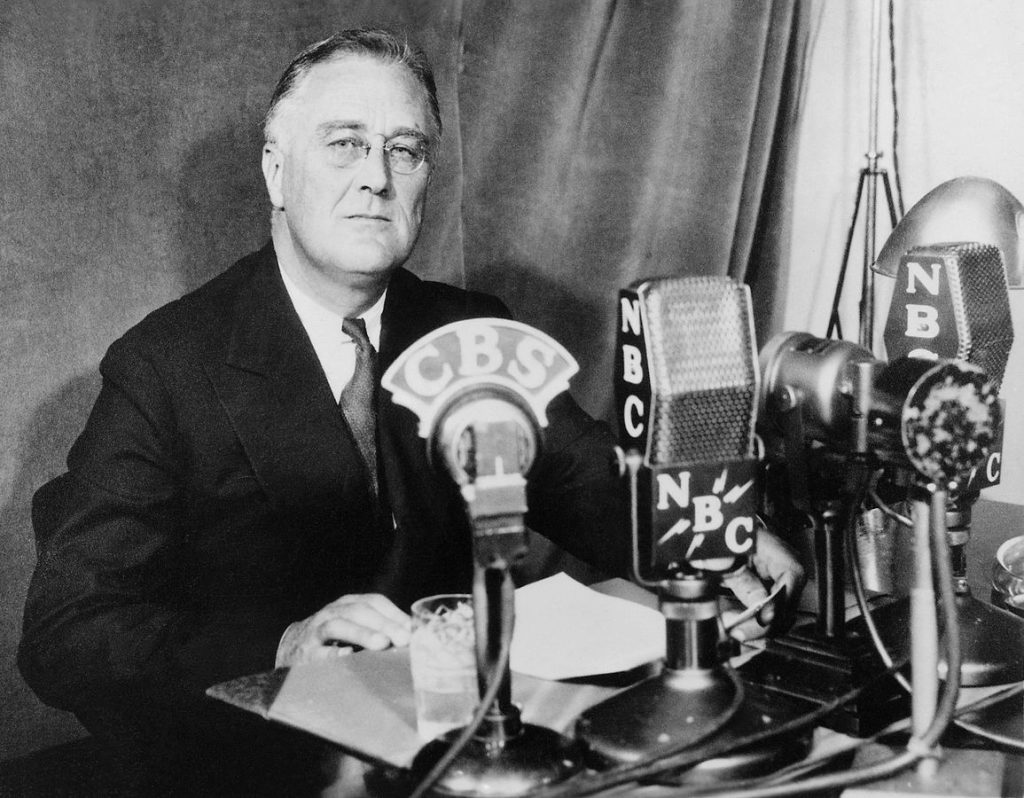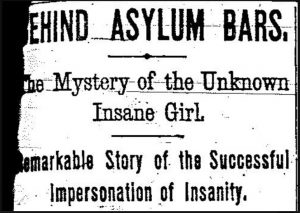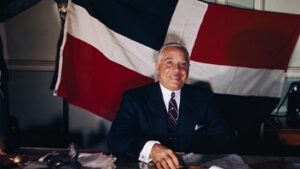BOOSH…In an instant the United States naval base, Pearl Harbor, was attacked by Japanese military planes; hundreds of U.S. military personnel, as well as U.S. civilians, were killed. The country was shaken to its core, even President Franklin D. Roosevelt. President Roosevelt wasted no time on that afternoon and evening of December 7, 1941. Within mere hours, President Roosevelt established a War Council meeting to address his most trusted officials, informing them that entering the war had now become a reality. After that War Council meeting, President Roosevelt was in dire need of rest, to recover from the news of the bombing, so much so that President Roosevelt required his otolaryngologist to treat his inflamed and swollen nasal passages. Even though the attack was clearly taking its toll on FDR, he only rested for a short period of time before calling three more meetings, which lasted through the night and into the morning of December 8, 1941.1
After the meetings with the President’s staff in the morning of December 8, Roosevelt addressed Congress in one of the most historical speeches in American history, declaring that the day that Japanese attacked Pearl Harbor would be a “date which will live in infamy.”2 Then, President Roosevelt leveraged the infamous attack to justify a declaration of war on Japan to avenge the fallen. In response to Roosevelt’s overwhelming passion, as well as the country’s anger and vulnerability, the majority of Congress passed the declaration of war on Japan. With the passing of the declaration of war, it was made clear that the request for war was limited to Japan because their military had acted alone in the bombing. Roosevelt, however, really wanted to go to war with not only Japan, but also with Germany and its ally Italy. So, in order to rage war on Hitler and all of his allies, Roosevelt had to put pressure on Hitler using one of his official radio addresses to the public. These official radio addresses were known as “Fireside Chats,” which Roosevelt had begun at the beginning of his presidency in 1933. In these radio “chats,” President Roosevelt provided comforting and informative words to the American public so that they could have some reassurance. Two days after the attack on Pearl Harbor, Roosevelt gave his highly anticipated “Fireside Chat,” where he stated that “Germany and Italy, regardless of any formal declaration of war, consider themselves at war with the United States at this moment, just as much as they considered themselves at war with Britain or Russia.”3 Such a statement immensely added to Hitler’s reasons for finally declaring war on the U.S. on December 11, 1941.

Prior to the bombing of Pearl Harbor, almost all of President Roosevelt’s “Fireside Chats” were about how the U.S. needed to stay out of the war. So, one might think that American citizens would be angered at President Roosevelt’s flip to engaging in the war. But in fact, a large majority of American citizens stood behind Roosevelt in engaging in the war. Thus, when the United States officially entered the war, everyone, even the people who claimed to support isolationism, found some relief in the fact that the country was taking steps to avenge their people. Though, all reliefs could not be quelled with the action of war, due to the simple fact that a majority of U.S. citizens still felt high levels of vulnerability because of their “enemy,” the Japanese-Americans, being their next-door neighbors. Now, Japanese-Americans had long been a disliked and unwelcomed people long before the Japanese attack on Pearl Harbor. Their coming to America and taking jobs from the already existing U.S. citizens had long stirred zenophobic anxieties. 4 So now with a Japanese attack having taken place on U.S. soil, those anxieties rose even higher against the Japanese-Americans. Many of these Japanese-Americans were intuitive enough to realize that resentment was coming, and went to great lengths to either reassure their fellow U.S. citizens or hide from them. For example, Saburo Kido, the president of the Japanese American Citizens League (JACL), took the initiative to send a telegram to President Roosevelt informing him that “Japanese-Americans are stunned and horrified at…[the] unwarranted attack by Japan upon American soil, our country. We want to convey to you that we unequivocally condemn Japan for this unprecedented breach of good faith.”5 Kido even pledged that the JACL would do everything possible to assist in “the defense of [their] land against this attack [and relinquish their] fullest cooperation” to President Roosevelt and the United States. Although Kido and the JACL relayed some reassurance to President Roosevelt, they were not successful in squashing the rumors about Japanese spies in America. Somehow newspapers got a hold of “evidence” proving that Japanese spies were to blame for Pearl Harbor, and many citizens believed them without a doubt, because they wanted so badly to see the Japanese-Americans as the enemy. Such negative sentiment was fueled by newspapers that ran headlines like “Slap the Jap Rat,” and consequently drove Japanese-Americans into hiding by claiming that they were of another Asian ancestry, so that they could avoid as much hatred as possible.
Quickly, hiding became ineffective for Japanese-Americans, because citizens who were not Japanese began to apply pressure on the government to ensure their safety by placing regulations on Japanese-Americans. The first step in these regulations was a 9:00 P.M. curfew for “enemy aliens,” which was a legal way of saying Japanese-Americans. It was enacted on February 4, 1942. This major regulation on Japanese-Americans, however, was not satisfying enough to West Coast citizens and political officials who felt more vulnerable due to their close proximity to Japan and their higher Japanese-American populations. So, where do they go from here? They went to President Roosevelt to demand that he take action to protect the majority of U.S. citizens by pushing the Japanese-Americans two-hundred miles inland, for the “safety” of all.6 For awhile, President Roosevelt chose to evade the pressures of the West Coast, and he even avoided his advisers, because he recognized that the status of Japanese-Americans was a sensitive situation; he had to balance safety and rights. Did the safety of one group of citizens require that another group of citizens had to sacrifice their rights? Unfortunately, as war tensions escalated so did the ideas for regulating Japanese-Americans. In fact, the ideas even called for their relocation. This idea of relocation suggested that Japanese-Americans had to be moved inland and be monitored by military authorities. Again, President Roosevelt realized the injustice in the action of relocating all Japanese-Americans, but he became overwhelmed by plea after plea from U.S. citizens and government advisers about how the relocation was a “military necessity” that would protect the country from “Japanese spies.”7 So, like any human being, President Roosevelt gave into the pressures of war, and chose to sacrifice Japanese-American rights by signing Executive Order 9066 on February 19, 1942.

In short, Executive Order 9066 authorized the “War Department to designate certain land as military areas and handing it the right to evacuate from those areas anyone it deemed a threat,” though the order would go on to only be enforced against Japanese-Americans on the West Coast.8 Furthermore, February 19 was only the dreadful day that President Roosevelt signed Executive Order 9066. It wasn’t until March 9, 1942, when the order began to shatter thousands of loyal Japanese-American lives.9 The evacuation began with “Civilian Exclusion Orders” posted in all areas with Americans of Japanese ancestry, detailing what to do as far as belongings and where to go. Ultimately, the Japanese-Americans cooperated because they felt it was the simplest way to reassure the country that they were no threat. Though, just because they cooperated didn’t mean that the U.S. military went easy on them. In fact, one of the harsh requirements on all Japanese-Americans was for them to sell their property because it was deemed that they would no longer need their property. From here, the Japanese-Americans would live in military internment camps that were located in unirrigated deserts that left them to suffer in scorching heat or icy cold weather. Ideally, these camps were built to allow the internees to go about their lives working and learning, but just in a military and barbed wire area. Now, there were no gas chambers or crematories, but internees were still abused and occasionally killed under mysterious circumstances. So, no, these camps were nothing like the German Death Camps, or even German concentration camps that existed at this same time; but they were nonetheless a nightmare for Japanese-Americans, and a complete violation of their rights as citizens of the United States. 10

As the war was drawing to a close, and progressing in the United State’s favor, President Roosevelt recognized that there was no longer any justification for holding Japanese-Americans behind barbed wire. So, in December of 1944, President Roosevelt rescinded Executive Order 9066 and announced that all Japanese-Americans could return home on January 2, 1945. After Roosevelt’s announcement, all camps were officially closed in early 1946, because the government wanted to ensure all of the internee’s loyalty to the United States.11 Now, just because President Roosevelt announced that all Japanese-Americans were freed doesn’t mean that they were immediately loved. In fact, they were discriminated against even more. Part of this discrimination was due to the strong emotions aroused by the war. People felt that they were still justified in their discrimination of Japanese-Americans because of the creation of the internment camps. President Roosevelt might have been able to sooth the people faster with a Fireside Chat or by encouraging the reintegration of Japanese-Americans, but he died from a stroke on April 12, 1945. So, with the loss of President Roosevelt, the Japanese-Americans were left to fend for themselves to regain trust from their fellow countrymen. Consequently, the Japanese-Americans would have to wait forty-three years for resentment to reach a level where they would receive an official apology from their government, and twenty-thousand-dollar compensation for the life-scarring internment. But no amount of money or apologies can ever undo the horrific actions the United States government conducted in one of its darkest hour.12
- Paul Burtness and Warren Ober, “Provocation and Angst: FDR, Japan, Pearl Harbor, and the Entry into War in the Pacific,” Hawaiian Journal of History 51, (2017): 108-110. ↵
- Greg Robinson, By Order of The President: FDR and the Internment of Japanese Americans (Cambridge, Mass: Harvard University Press, 2001), 74. ↵
- Paul Burtness and Warren Ober, “Provocation and Angst: FDR, Japan, Pearl Harbor, and the Entry into War in the Pacific,” Hawaiian Journal of History 51, (2017): 110. ↵
- John F. Wukovits, Internment of Japanese Americans (Detroit: Lucent Books, 2013), 15-17. ↵
- John F. Wukovits, Internment of Japanese Americans (Detroit: Lucent Books, 2013), 21. ↵
- John F. Wukovits, Internment of Japanese Americans (Detroit: Lucent Books, 2013), 20-29. ↵
- John F. Wukovits, Internment of Japanese-Americans (Detroit: Lucent Books, 2013), 30-32. ↵
- John F. Wukovits, Internment of Japanese-Americans (Detroit: Lucent Books, 2013), 32. ↵
- “Executive Order 9066 passed in the US,” History Today 67, no. 2 (2017): 9. ↵
- John F. Wukovits, Internment of Japanese-Americans (Detroit: Lucent Books, 2013), 34-40. ↵
- John F. Wukovits, Internment of Japanese Americans (Detroit: Lucent Books, 2013), 96-97. ↵
- Joyce Moss and George Wilson, Literature and Its Times: Profiles of 300 Notable Literacy Works and the Historical Events that Influenced Them (Detroit: Gale, 1997), 137-143, http://link.galegroup.com/apps/doc/CX2875100248/GVRL?u=txshracd2556&sid=GVRL&xid=489a8828. ↵



76 comments
Marina Castro
I really enjoyed reading this article! This topic is so controversial because of the historical and sociological context it occurs in. Everything that happened during the war had strong repercussions on the lives of many families. It is sad to read about people all over the world had to suffer. This article did a great job at narrating the events that occurred.
Martina Rodriguez
I had no idea that extreme amounts of stress could inflame nasal passages. I’ve heard of the term “Fireside Chats” but I didn’t know exactly what the term referred to. I loved the image of the poster and I wasn’t too surprised about the fact that many Americans who previously hadn’t supported war efforts were now approving engaging in the war effort. I liked how Roosevelt at least addressed the allegiance of Japanese Americans to the country, but sadly it didn’t have much of an effect.
Mariah Cavanaugh
I recently finished making a video about the Crystal City Internment Camp in Crystal City, Texas. It was a family internment camp which consisted of Japanese-Americans as well as German-Americans. Although I was initially turned off by your title because you referred to it as relocation as opposed to imprisonment, which it was. You did do a great job of unfolding the story and pointing out that this is a dark mark in American history
Daniel Linstead
This is something that I never knew of until I read this article. I found it very informative and learnt a lot about this topic. The article was very well written. I found it interesting that even though people could have been American Citizens, they were still forced into these camps. I don’t understand why you can treat people like this but even the people that are deemed your people doesn’t make sense to me.
Michael Hinojosa
This article was not only extremely impressive in terms of the visuals but also how it was written! I remember learning about this topic in my history classes but we never spent a lot of time going over them since I imagined thats how the education system worked for us in regards to the nastiness that plagues our history. I’m glad that after reading this I was able to learn more about this topic!
Faten Al Shaibi
This article was very informative that allowed me to understand the why america’s participation in World War II. I think it’s stupid to attack a strong country like America.
Especially if your country are small and weak.
You may win a tour. But in the end you will lose everything.
America lost in Pearl Harbor near 3,000. But Japan lost almost 140,000
I hope that this incident will not be again, so as not to lose the lives of people, which is more important than anything in this life.
Greyson Addicott
Setting its historical context aside, I find it still shocking today that the Federal government believed it possessed the power to condemn (without justification) a large amount of people from the several sovereign states into prison camps. We seem to ignore the power behind the federal government that was used for the action, opting instead to focus upon the implications of the order itself. How did the Union fall so far, and erode so thoroughly, as to allow a despotic Federal head to do such a horrible grievance against the various states without their consent? Was this not exactly what our founding fathers warned against? Indeed it was! Why then, are we so contempt to sit here in stagnation, and act as if it meant nothing? Ask yourself this- what, exactly, bars our Federal government from rounding up a different ethnicity today? Will your beloved state come to your aid if the government wants to drag you to Nevada? Probably not. How could it, when they are little more than administrative zones that we constantly abuse and take for granted? The ideas behind this article are plentiful and deep!
Mariana Valadez
this article was full of information that I was completely unaware of. It was extremely interesting, but it was sad to read what Japanese-Americans went through. It is crazy to read how these camps came to be. This article was extremely well written and filled with things that blew my mind. I enjoyed reading it and it kept me on my toes the entire time.
JM
Very good article. History should not be forgotten. This is especially relevant in today’s world with everything going on. I remember hearing people making comparisons between the immigration centers and these internment camps during WWII. I didn’t know a whole lot about these camps, but now I do!
Lyzette Flores
This article contained a lot of information, therefore, making it a great one! What the Japenese-Americans lived through must have been horrible. I totally understand as to why they felt betrayed. Especially those who had nothing to do with the attack and I bet there was a majority of them. There aren’t enough compensations as to why they were put through that but at least the government can see that and learn from their mistakes.